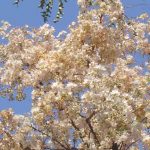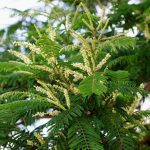TREE LIFE
March 1985
MASHONALAND CALENDAR
Tuesday March 5th: Botanic Garden Walk. Meet in the Car Park at 1645 for 1700 hours.
Sunday March 17th: AGM and outing to Danbury Park Farm on the old Mazowe Road. We have recently had another look around and found a couple of really nice spots to walk in with a very interesting variety of trees looking super with the recent rains. I am still keen to have a re-visit to the wishing tree we saw on our last visit, but we will have to see what time permits.
The AGM itself will be held at the farm house itself at 12 noon so we will stop treeing a little early in order to get down to and through this necessary business. Please refer to Tree Life No. 59 for the format, Notice and Agenda. I hope to include the Minutes of the last AGM with this issue. Please also give much thought to nominations for Committee and Office bearers as requested before.
No bus has been booked. Being relatively close to Harare and with rising costs, the necessary fare would render this quite uneconomical. Instead, we will share transport as we have done in the past with much success. Please meet at the Monomatapa Car Park at 0830 to sort out lifts with the object of arriving at about 0915. We urge those who can offer lifts to do so as it is important to have a good representation at the AGM.
MATABELELAND CALENDAR
Sunday, March 3rd: Meet at Mr. Sykes’house, 1 Founders Road, Richmond to visit part of the Helensvale Block, at 0830 hours.
BOTANIC GARDEN WALK 8TH JANUARY AND 5TH FEBRUARY 1985
The rain which threatened both of these walks eventually stopped, and so we were able to examine two closely related indigenous families, the BORAGINACEAE and the VERBENACEAE. Within the taxonomical hierarchy they belong to the most advanced subclass within the dicotyledon class. This subclass is the Asteridae, named after the daisy, the Aster. Subclasses are divided into orders and both these families, together with a third well known family the LAMIACEAE, also called LABIATAE, belong to the order Lamiales. All of these families lack stipules and are traditionally considered together because there are a number tendencies which start within the BORAGINACEAE and become progressively more pronounced in the VERBENACEAE, and finally characterize the LAMIACEAE. One of these trends is seen in the floral structure. The flowers of the BORAGINACEAEA are radically symmetrical whereas the VERBENACEAE often have a stronger bilateral symmetry. This feature is thought to be an adaptation to insect pollination as it is often provides a flat landing platform for flying insects.
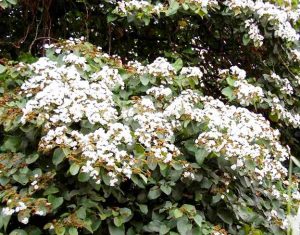
Cordia abyssinica. Photo: Bart Wursten. Source: Flora of Zimbabwe
The first member of the BORAGINACEAE which Tom Muller showed us floored me entirely as it lacked all the vegetative features which in my mind represent this family, so possibly we should introduce the family while considering the large specimens of Cordia abyssinica which grow behind the herbarium. The leaves of BORAGINACEAE usually have characteristic unicellular hairs which coat the leaf. These hairs have a particular structure and often contain deposits of calcium of silica within the walls, these features of the hairs lend a distinctive, rough feel to the BORAGINACEAE leaf. This texture is familiar to anyone who has felt comfrey, Smphytum, which is one of the few members of the family with any commercial value. The BORAGINACEAE have simple, mostly entire leaves which are usually alternate, although the lower ones on the twig may be opposite. This is another trend which progresses towards the opposite leaves of the VERBENACEAE and LAMIACEAE. C. abyssinica is a pioneer tree and as such grows rapidly, these large specimens were planted out just over a decade ago and flower profusely, littering the ground with many white hat like structures, each one formed by the 5 fused petals. Although each flower is short lived the tree comes into flower repeatedly. C. abyssinica grows on Murahwa’s Hill, Mutare, Cecil Kop and in the upper Rusitu Valley. We may remember a memorable Shamva trip in which the white blossoms caught the golden late afternoon light and were theatrically emphasized by a back drop of heavily laden storm clouds. On the February trip to Shamva Dick showed us C. pilosissima which Tom has alongside the Ficus bubu lawn at the gardens. In contrast to the tree habit of C. abyssinica, C. pilosissima forms an overgrown multi trunked bush with rounder leaves. In the botanic gardens we saw the developing ovary with its persistent calyx which fits loosely around the base of the fruit like an acorn.
On the February walk Tom continued with the genus Cordia examining the large scrambling specimens of C. ovalis where the hairs are so pronounced the round leaf is as abrasive as sandpaper. This species comes from the southern lowveld and has a fluted trunk with a smooth hard bark which flakes off exposing a lighter under surface. Nearby we saw C. sinensis also from the Sabi Valley although it may be found in the Zambezi Valley. Here opposite leaves are more frequent than alternate and the upper half of the leaf maybe markedly serrate. C. goetzei which grows along water courses in Gona-re-zhoe and the Zambezi Valley often develop square stems and has longer more elliptical leaves than the other Cordia species. While still in the S.E. Lowveld section of the Garden Tom showed us C. grandicalyx with large round leaves. This Cordia is not fluted and may also be found in the Matopos.
The BORAGINACEAE often have complex chemicals within their tissues. These chemicals are called secondary compounds and were thought to be by-products of the plants’ biochemical pathways. Now it is generally recognized that secondary compounds have an important role in plant/animal interactions. Decoctions from one BORAGINACEAE, Lithospermum ruderale have a pronounced contraceptive effect, and were used by the American Indians in Western North America. This plant apparently provided the inspiration for the development of commercial oral contraceptives, Cronquist, 1981. Some BORAGINACEAE, contain alkaloids which are toxic to birds but not to adult butterflies. Male denied butterflies are known to land on old, dried leaves and secrete a saliva which dissolves out these alkaloids and then, by reingesting the exudation, they accumulate high levels of these toxins within their bodies. This protects them against being eaten by birds. Dr Ian Gordon, a lecturer at the University of Zimbabwe, has been unable to illicit this response from butterflies when using the Cordia species which grew in West Africa, and hopes to try the other indigenous tree genus, Ehretia, in the near future. Butterflies are reported to be attracted by the local herbaceous BORAGINACEAE.
There are at least three species of Ehretia in Zimbabwe. The lowveld woodland species E. rigida has obovate leaves arranged in fascicles and sometimes with a short sharp lateral spur. Around Bulawayo where this plant may be confused with Maytenus heterophylla, the acid test is to run a finger down the edge of the blade; with Ehretia, the BORAGINACEAE hairs catch the finger whereas in Maytenus the margin is smooth. There are so few hairs on the leaves of the fast growing rain forest pioneer, E. cymosa var divariceta that they appear glabrous. This was the strange species I referred to in the beginning of this article. It may have long sucker shoots and grows into a large tree in Chirinda forest and at medium altitudes near Mtarazi Falls. The slash is white but clouds over rapidly to a dark colour. Like E. rigida, this forest species may have pockets in the axils of the veins known as acarodomatia.
There is a bit of confusion as to the status of the other species of Ehretia, and three names come to mind; E. amoena, E. coerulea and E. obtusifolia. From these three names there may be one or two actual species. The specimen labeled E. amoena which is on an ant hill in the Gardens has small hairy leaves with neither acarodomatia nor lateral spurs and not as blue green as those of E. rigida. Tom did not want to be too dogmatic and suggested a possible muddle with E. rigida. In either case this tree was very different to a large leaved Ehretia specimen on the path from the ant hill to the Anthocleista lawn. There was apparently once a distinction between E. amoena and E. coerulea based on the presence of hairs on the inflorescence but then the umbrella term E. obtusifolia refers to both of these apparent species. The herbarium specimens have been sent away so that this confusion may be sorted out.
It is difficult to discuss the VERBENACEAE without first referring to the LAMIACEAE which we know in the form of Iboza, sage; Salvia, mint; Mentha catmint; Nepeta, origanum; thyme Thymus; basil Ocimum and rosemary Rosmarinus. The trends which begin in the VERBENACEAE are accentuated within the LAMACEAE and therefore in retrospect they take on greater significance. The LAMIACEAE generally have a smell when crushed, just think of any of the above members. The feature is less pronounced in the VERBEACEAE although aromatic leaves may be found in Lantana, Premna, Clerodendrum and Lippia. An oil extracted from one species of Lippia is marketed in the perfume trade as verbena oil. LAMIACEAE are characterized by opposite leaves on square stems, In the VERBENACEAE the young twigs are often quadrangular and the leaves are opposite or may whorled e.g. Clerodendrum glabrum. Both of these families have iridoid compound within the leaves, these compounds may help to deter insect predators, and may result in pressed leaves turning black on the herbarium shelves instead of drying brown. The VERBENACEAE generally have simple leaves although the largest indigenous tree genus, Vitex is characterized by palmately compound leaves. We usually see the VERBENACEAE growing as large bushes, small trees or scrambling shrubs, but they do form trees as in the exotic Tectona grandis, the Burmese Teak.
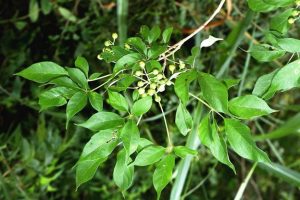
Vitex buchananii. Photo: Bart Wursten. Source: Flora of Zimbabwe
The first VERBENACEAE species we examined was Vitex buchananii. We noted the finely hairy, opposite leaves, each with fine palmate leaflets. The leaflets vary in size, somewhat reminiscent of some CAPPARACEAE, although in this latter family the leaves are alternate. Each leaflet is attenuate which is indicative of the forest edge environment in the Haroni Rusitu Valley. Within the forest section Tom knocked down a branch from a large specimen of Vitex doniana with large, broad, leathery leaflets without hairs on the upper surface. This spreading tree grows below 800 m as a high rainfall forest edge plant; and may be found in the valley burial grounds. Standing alongside, and overhanging the path opposite the Euphorbia bed we examined Vitex sp. no. 1. With its heads of cream, bilaterally symmetrical flowers. This is a rare species of the Chirinda forest edge. These soft leaflets generally have long petiolules. A bit later in the walk we also saw Vitex payos, the chocolate berry we are so familiar with around Harare.
We wandered past numerous Mondea whitei seedlings which have escaped the ravages of the local aphrodisiac hunters who seek the roots. In the rocks beside Bequaertiodendron we found V. amboniensis of outlying forests around Zimbabwe Ruins and Nyoni mountains as well as at Ratelshoek in the Eastern District. We noted another common VERBENACEAE – that of finely vertically fissured bark. The small leaf is finely hairy and the developing fruit was still small, it apparently grows to over an inch long.
Further along the path we found a large Clerodendrum glabrum with its stinky leaves in whorls of three. The entire margin contrasts with the serrated edge in C. myricoides of Mashonaland woodlands. Here the leaves grow in pairs and stink less than C. glabrum. We saw the flowers of C. myricoides which are similar to those on the exotic species of Clerodendrum commonly grown in local gardens and called “Oxford and Cambridge” due to its light and dark blue petals. In the Highland section we saw two other species C. wildii with its purple petioles and a smell which eclipses all the other species. It grows on granite kopjes and also as a forest outlier near Inyanga. C. violatsium also has opposite decussate leaves. Tom’s small specimen, which resembled a simple leafed dahlia, was collected in the rocky hills on the right of the Inyanga road, just beyond London Store where it grows alongside Tarchonanthus. Back tracking to beneath the large Albizia gummifera alongside the Anthocleista lawn we found the scrambling Clerodendron swynnertonii with forest leaves and a petiole like many of the Combretum species which grows into a spine after the leaf has fallen and helps support the branches.
Alongside the Cordia pilosissima Tom was surprised to discover his Premna senensis had grown into a sizeable bush. This streamside species grows in the north of Zimbabwe and may be seen at Victoria Falls. We headed back to the car park where we found Holmskoldia tettensis in full flower with a mauve blue Chinese hat formed by the persistent calyx. These fade in the bright sunlight of the jesse bushveld but help to identify the tree for many months of the year. This species may also be found on the Zambezi escarpment.
With the walk officially over, Tom showed us the hanging inflorescence on Barringtonia racemosa, a coastal tree from Natal and Mozambique which belongs to the LECYTHIDACEAE. Each flower has numerous long stamens which form an impressive show. We must thank Tom for yet another informative walk. Next month we will be continuing with the LOGANIACEAE in the traditional sense, which we began in February.
-Kim St.J. Damstra
GOLDEN STAR RANCH, SHAMVA SUNDAY 17TH FEBRUARY 1985
Visiting the Logan’s farm is like entering the National Gallery in London. Firstly, there is no point trying to see everything for fear of seeing nothing and secondly there is no use attempting to document more than a fraction of the sensory input, so I will be skimming the skimmings and refer you to the full report on Golden Star by Paul Coates Palgrave in the newsletter of December 1981.
The past few weeks of rain have done wonders to the local vegetation and as we drove past Mazowe Dam looked healthier than it has been for a long time. Beyond Bindura we noted the spindly shoots of Bindura bamboo, Oxytenanthera abyssinica reaching upwards in preparation for their ultimate flowering and then death. The tall clump of Oreobambos in the Botanic Gardens which flowered so profusely last year is now dead, and only a few brittle stems mark the place where it once stood.
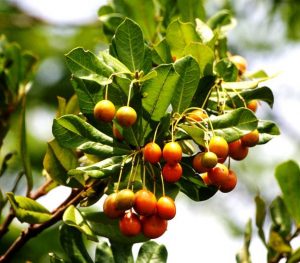
Merua kirkii. Photo: Bart Wursten. Source: Flora of Zimbabwe
Dick Petheram who met the bus beneath a tall pink jacaranda, Stereospermum kunthianum, and Dick’s son in law Aubrey Logan, had arranged a full and varied program for the day. One of the first stops was to see a large Maerua kirkii growing on a termite mound and covered in gleaming orange red oval fruit. The leaves of this species bear a remarkable similarity to those of the genus Boscia which also belongs to the family CAPPARACEAE. In both cases the leaf is dark green with a stiff, dry texture and the pale mid vein stands out below the blade like a pipe. The end of the leaf has a sharp tip, once again a feature commonly found in Boscia. The stalk on which the fruit hangs has a joint pathway along it. This joint marks the position of the other floral parts, we may remember the CAPPARACEAE flowers of Cladostemon kirkii from the Botanic Gardens, where the ovary is held away from the flower on a long stalk or androgynophora. Later in the day we saw this jointed stalk again on the fruit of Capparis tomentosa which scrambles into trees, supported by means of re-curved hooks. Once again we must chastise ourselves for not looking out for the other species of Capparis as Dick has collected the smaller fruited C. sepiaria a short distance downstream from Golden Star, so it may well grow on the farm.
In close proximity we found both Albizia amara and A. harveyi, so we tested the differences which we had seen in the Botanic Gardens in December. The leaflets of A. harveyi were markedly sickle shaped and thorns were present on the branches although the position of the gland on the petiole did not help us in A. amara a number of these glands were also on the top half of the petiole.
At the farmhouse we were greeted by a sumptuous tea organized by our hostess, Edone Ann Logan, and her mother, Edone Petheram, both of whom worked tirelessly at unparching throats. Around the farmhouse we found a fruiting Crossopteryx febrifuga, a magnificent Xeroderris stuhlmannii with its square seed and distinctive pod, Holarrhena pubescens, Phyllanthus reticulatus and a planted Albizia glaberrima. There was also a tall marula, Sclerocarya birrea which allowed us to note the numerous, usually more than 15, leaflets held onto the rachis by long petiolules. At the Mazowe where we had lunch later in the day we found multi trunked bushes of the false marula, Lannea schweinfurthii which differs in having less than 10, often only 3, sessile leaflets per leaf. Both of these species belong to the ANACARDACEAE.
Aubrey had organized two tractor drawn trailers decked out with seating constructed from sacks of mealies. This luxury allowed an unhampered view of the passing trees as we headed for the banks of the Mazowe River. Here we found a tree I am convinced we pass more frequently than we notice, the wild custard apple, Annona senegalensis. It has the ANNONACEAE growth habit but the leaves are broader and rounder than the other genera, although they are often obovate like most ANNONACEAE. The ping pong ball sized fruit is fused into a scaly mass and does not consist of a bunch of sausage shapes as we saw in Friesodielsia obovata. On the path down to the river we looked to see a heavy tennis ball size fruit. This could only belong to Monodora junodii, a species which flowers but has never fruited in the Botanic Gardens. This fruit is also a typical within the ANNONACEAE but is quoted as being one of the reasons why the family CANNELLACEAE is now placed close to the ANNONACEAE. Just in passing the Warburgia of the CANELLACEAE which have never flowered in the Botanic Gardens are now in young flower bud. M. junodii has very tapered leaves, broadest near the tip.
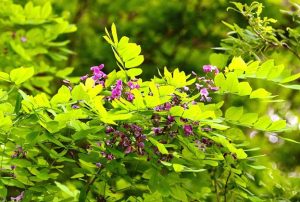
Milletia usaramensis. Photo: Bart Wursten. Source: Flora of Zimbabwe
The next puzzle entailed alternate imparipinnate leaves with a pair of stipels associated with each pair of leaflets. This naturally takes one directly to the pea family, FABACEAE or PAPILIUNOIDEAE. Similar structures are found in Indigofera and Lonchocarpus, but this turned out to be Millettia usaramensis which was common along the riverbank. In early summer these bushes are covered in purple pea like flowers. Alongside Millettia was Dalbergia arbutifolia which scrambled into taller trees. The forest under storey was filled in with the yellow Bauhinia tomentosa with their bell like flowers inside of which each petal has a deep maroon patch. It is noteworthy that Hibiscus vitifolius, family MALVACEAE, which also grows on the farm has an identical colour combination. We also saw the white B. petersiana in full bloom, although here the petals are strap shaped and thus the flower is more open.
We were diverted by a creeper covered in translucent orange fruit. The leaves were fleshy and snapped sharply when folded, the brittle branches broke off in a manner not unlike that of Loranthus or Olax. After some thought Gill Masterson quietly solved the problem; Opilia celtidifolia of the family OPILIACEAE – a family closely associated with the OLACACEAE, Olax, SANTALCACEAE Osyris , and the LORANTHACEAE. Yet another vegetative feature falls into place.
Lost amongst the lowveld gems we forgot about time and lunch. Just recall Flacourtia indica with what Paul described last time as “thorns growing upon thorns”, Strychnos madagascariensis which lacks the powdery bark present on S. innocua; the yellow sap of Garcinia livingstonei with simple leaves in whorls of three, Commiphora pyracanthoides described as “compound leaf but with a single leaflet”; Ficus sansibarica; Nuxia oppositifolia, strange ground orchids; rushing waters and biting midges, it was time to move on.
Back on the trailers we headed off through the cotton fields to the rapids upstream. After a restful lunch we found Ochna rovumensis with bright red persistent calyx, Ficus capreifolia with abrasive leaves, Berchemia discolor Markhamia acuminata and Holstia tenuifolia, EUPHORBIACEAE. Returning to the farmhouse we passed beneath two streamside Ekebergia capensis. After yet more tea, homemade lemon juice and eats we boarded the bus and returned via the Shamva road. The Logan’s have invited us again sometime, and I dare say we may well do so as we have hardly touched the diversity of vegetation. To Aubrey and Edone-Ann and Dick and Edone, our heartfelt thanks for your generous hospitality and a most memorable trip.
-Kim ST.J. Damstra
MATABELELAND NOTES
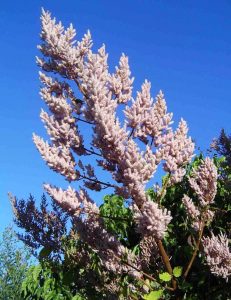
Iboza riparia. Photo: Bart Wursten. Source: Flora of Zimbabwe
On Sunday 6th February we went to Mbukuweni. This had been Tom Meikle’s choice for his house site and is now a Nature Garden. He certainly chose well as in a couple of hours we saw nearly 80 different tree species. Amongst these were five Acacia species; A. gerrardii, A. karroo, A. nilotica, A. rehmanniana and A. sieberiana. Cassine matabelica and an unusually thick and heavy leaf and Catha edulis caused some confusion. There were three species of Combretum, C. apiculatum, the mouse ears of C. hereoensis and C. molle. Although both Commiphora africana and C. schimperi is velvety whereas in C. africana the leaves lack hairs. We also saw the compound leaves of C. mollis and thought we found Crossopteryx febrifuga. Amongst the rest we also saw Ficus glumosa, Iboza riparia, Lantana camara, a large Lippia javanica, Mundulea sericea, Olea europea subsp africana, Osyris lanceolata, Schrebera alata, Sclerocarya birrea and Zanthoxylum capense. We are sure that there are lots more which we did not observe this time. This is a great variety for so small an area.
-C.Sykes
Dear Friends,
It may be of interest for members to know that I made contact with Ray Parry of Kamativi and went out to see the yellowwood, which he mentioned in Newsletter Tree Life No. 56, recently. Unfortunately the tree in question turned out to be Boscia salicifolia, however a very enjoyable day was had by the four of us who spent the day climbing up and down Chinghali Mountains near Kamativi, and I was able to collect some seeds of Ximenia americana, Ximenia caffra and Erythroxylum zambesiacum. I was also able to collect an interesting plant of the PERIPLOCACEAE family, Pentagonanthus grandiflorus which has a beautiful azure blue flower. This plant has been collected only very seldom in this country as it is only a low growing sub shrub and would not be noticed except when in flower.
Anton F. Ellert
Dear Sir,
In response to your request for a theory as to the reasons for the peeling trunk common to many trees growing on kopjes, I have the following to offer. As opposed to the fire resistant corky bark of the savanna species or climate induced adaptations of desert and high altitude species, the peeling bark of the kopje trees has evolved as the result of the need for protection against tree climbing animals.
Kopjes such as the Matopos are the favoured habitat of hyraxes and the night refuge of baboons and monkeys. The former are very partial to budding green leaves which are generally accessible to them because of their agility on the slenderest of branches, while the latter, especially baboons, can be very damaging to the trees in which they roost at night. From the point of view of the kopje tree, it can not be much fun serving the purpose of a larder for hyraxes and a jungle Gym and dormitory for monkeys and baboons. Whereas trees such as the acacias have thorns with which to protect themselves from some of the more tender mouthed browsers, these kopje trees have had to resort to a more subtle method for deterring tree climbers. Thorns are no problem to a baboon or monkey. Nor is an extremely smooth trunk, as long as it is not too thick. By pulling with his hands and pushing with his feet as he goes up the monkey or baboon is able to scale it quite easily.
But ……………………….. with papery bark that flakes off immediately any pressure is put on it, imagine the difficulty of gaining a purchase. And for a hyrax which might have leapt from an adjacent rock onto the branch of one of these trees, picture the hazard of it suddenly finding itself with a papered section underfoot.
I have not put these theories to the test by careful observation and may well be barking up the wrong tree, so I should be interested to hear a few other points of view.
-Brian Ade
THE MAN WHO PLANTED HOPE AND GREW HAPPINESS by Jean Giono Continued from Tree Life No 55.
It was understood from the first that I should spend the night there; the nearest village was still more than a day and a half away. And besides I was perfectly familiar with the nature of the rare villages in that region. There were four or five of them scattered well apart from each other on these mountain slopes, among white oak thickets, at the extreme end of the wagon roads. They were inhabited by charcoal burners, and the living was bad. Families, crowded together in a climate that is excessively harsh both in winter and summer, found no escape from the unceasing conflict of personalities. Irrational ambition reached inordinate proportions in the continual desire for escape. The men took their wagon loads of charcoal to the town, then returned. The soundest characters broke under the perpetual grind. The women nursed their grievances. There was rivalry in everything, over the price of charcoal as over a pew in the church. And over all there was the wind, also ceaseless to rasp down the nerves. There were epidemics of suicide and frequent cases of insanity, usually homicidal.
The shepherd went to fetch a small sack and poured out a heap of acorns on the table. He began to inspect them one by one, with great concentration, separating the good from the bad. I smoked my pipe. I did offer to help him. He told me that it was his job. And in fact, seeing the care he devoted to the task I did not insist. That was the whole of our conversation. When he had set aside a large enough pile of good acorns he counted them out by tens, meanwhile eliminating the small ones or those which were slightly cracked, for now he examined them more closely. When he had thus selected one hundred perfect acorns he stopped and he went to bed.
There was peace in being with this man. The next day I asked if I might rest here for a day. He found it quite natural, or, to be more exact, he gave me the impression that nothing could startle him. The rest was not absolutely necessary, but I was interested and wished to know more about him. He opened the pen and led his flocks to pasture. Before leaving he plunged his sack of carefully selected and counted acorns into a pail of water.
I had noticed that he carried for a stick an iron rod as thick as my thumb and about a yard and a half long. Resting myself by walking, I followed a path parallel to his. His pasture was in a valley. He left the little flock in charge of the dog and climbed towards where I stood. I was afraid that he was about to rebuke me for my indiscretion, but it was not that at all; this was the way he was going, and he invited me to go along if I had nothing better to do. He climbed to the top of the ridge, 100 yards away. There he began thrusting his iron rod into the earth making a hole in which he planted an acorn; then he refilled the hole. He was planting oak trees. I asked him if the land belonged to him. He answered no. Did he know whose it was? He did not. He supposed it was community property, or perhaps belonged to people who cared nothing about it. He was not interested in finding out whose it was. He planted his hundred acorns with the greatest care. After the midday meal he resumed his planting. I suppose I must have been fairly insistent in my questioning, for he answered me. For three years he had been planting trees in this wilderness. He had planted 100 000. Of the 100 000, 20 000 had sprouted. Of these 20 00 he still expected to lose about half, to rodents or to the unpredictable designs of Providence. There remained 10 000 oak trees to grow where nothing had grown before.
That was when I began to wonder about the age of this man. He was obviously over fifty. Fifty five he told me. His name was Elzeard Bouffier. He had once had a farm in the lowlands. There he had had his life. He had lost his only son, then his wife. He had withdrawn into this solitude, where his pleasure was to live leisurely with is lambs and his dog. It was his opinion that this land was dying for want of trees. He added that, having no very pressing business of his own, he had resolved to remedy this state of affairs.
Since I was at that time, in spite of my youth, leading a solitary life, I understood how to deal gently with solitary spirits. But my very youth forced me to consider the future in relation to myself and to a certain quest for happiness. I told him that in thirty years his 10 000 oaks would be magnificent. He answered quite simply that if God granted him life, In thirty years he would have planted so many more that these 10 000 would be like a drop of water in the ocean.
Besides, he was now studying the reproduction of beech trees and had a nursery of seedlings grown from beechnuts near his cottage. The seedlings, which he had protected from his sheep with a wire fence, were very beautiful. He was also considering birches for the valleys where, he told me, there was a certain amount of moisture a few yards below the surface of the soil.
The next day we parted.
The following year came the War of 1914, in which I was involved for the next five years. An infantryman hardly had time for reflecting upon trees. To tell the truth the thing itself had made no impression upon me; I had considered it as a hobby, a stamp collection, and forgotten it.
The war over, found myself possessed of a tiny demobilization bonus and a huge desire to breathe fresh air for a while. It was with no other objective that I again took the road to barren lands.
The countryside had not changed. However, beyond the deserted village I glimpsed in the distance a sort of grayish mist that covered the mountaintops like a carpet. Since the day before I had begun to think again of the shepherd tree planter. Ten thousand oaks. I reflected. Really take up quite a bit of space. I had seen too many men die during those five years not to imagine easily that Elzeard Bouffier was dead, especially since, at twenty, one regards men of fifty as old men with nothing left to do but die. He was not dead. As a matter of fact, he was extremely spry. He had changed jobs. Now he had only four sheep but, instead, a hundred beehives. He had got rid of the sheep because they threatened his young trees. For, he told me, and I saw for myself, the war had disturbed him not at all. He had imperturbably continued to plant.
To be continued
PHILIP HAXEN
CHAIRMAN


